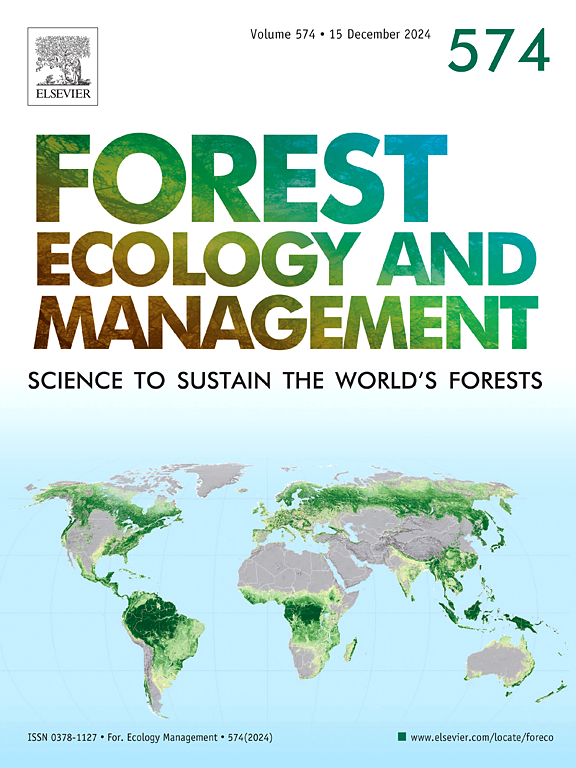Canopy nitrogen and water addition affect fine-root survival strategies and carbon allocation in a warm-temperate forest in China
IF 3.7
2区 农林科学
Q1 FORESTRY
引用次数: 0
Abstract
Fine roots adapt to habitat changes, influencing plant survival strategies. However, there is a limited understanding of fine-root survival strategies under different nitrogen (N) and water treatments. Therefore, in an eight-year field control experiment conducted in a warm-temperate forest, we investigated the effects of changes in fine-root survival strategies in response to canopy N, canopy water, and N–water addition on fine-root biomass and functional diversity. Increases in soil nutrients (available N and moisture) promoted a conservative strategy of fine roots in dominant species, as indicated by the community-weighted mean. Compared to increasing tissue density in the non-growth period (with a maximum 44.6 % increase under canopy water addition), increasing fine-root diameter (up to 55.1 % increase under canopy N–water addition) and competition mitigated (maximum 49.9 % reduction under canopy N addition) the decrease in nutrient absorption rate indicators during the growth period, especially for absorptive fine roots. The conservative survival strategy adopted by dominant species provided living spaces for other species, thereby increasing fine-root biomass at the community level (maximum 33.4 % increase in non-growing seasons and 39.3 % in growing seasons, both under combined canopy N–water addition), particularly for non-dominant species. Our study elucidates the changes in fine-root survival strategies under different contexts that reflect potential climate change scenarios, and provides important evidence on the relationship between functional diversity and subsurface carbon allocation.
中国暖温带森林冠层氮和水分添加对细根生存策略和碳分配的影响
细根适应栖息地的变化,影响植物的生存策略。然而,对不同氮和水处理下细根生存策略的了解有限。因此,我们在暖温带森林进行了为期8年的野外对照试验,研究了冠层氮、冠层水分和氮水添加对细根生物量和功能多样性的影响。群落加权平均值表明,土壤养分(速效氮和水分)的增加促进了优势种细根的保守策略。与非生长期增加组织密度(在冠层加水处理下最大增加44.6% %)、增加细根直径(在冠层加水处理下最大增加55.1% %)和竞争(在冠层加水处理下最大减少49.9% %)相比,减缓了生长期间营养吸收速率指标的下降,尤其是吸收性细根。优势种采取的保守生存策略为其他物种提供了生存空间,从而在群落水平上增加了细根生物量(在冠层氮水联合添加下,非生长期和生长期的生物量增幅最大分别为33.4% %和39.3% %),尤其是非优势种。我们的研究阐明了不同环境下细根生存策略的变化,反映了潜在的气候变化情景,并为功能多样性与地下碳分配之间的关系提供了重要证据。
本文章由计算机程序翻译,如有差异,请以英文原文为准。
求助全文
约1分钟内获得全文
求助全文
来源期刊

Forest Ecology and Management
农林科学-林学
CiteScore
7.50
自引率
10.80%
发文量
665
审稿时长
39 days
期刊介绍:
Forest Ecology and Management publishes scientific articles linking forest ecology with forest management, focusing on the application of biological, ecological and social knowledge to the management and conservation of plantations and natural forests. The scope of the journal includes all forest ecosystems of the world.
A peer-review process ensures the quality and international interest of the manuscripts accepted for publication. The journal encourages communication between scientists in disparate fields who share a common interest in ecology and forest management, bridging the gap between research workers and forest managers.
We encourage submission of papers that will have the strongest interest and value to the Journal''s international readership. Some key features of papers with strong interest include:
1. Clear connections between the ecology and management of forests;
2. Novel ideas or approaches to important challenges in forest ecology and management;
3. Studies that address a population of interest beyond the scale of single research sites, Three key points in the design of forest experiments, Forest Ecology and Management 255 (2008) 2022-2023);
4. Review Articles on timely, important topics. Authors are welcome to contact one of the editors to discuss the suitability of a potential review manuscript.
The Journal encourages proposals for special issues examining important areas of forest ecology and management. Potential guest editors should contact any of the Editors to begin discussions about topics, potential papers, and other details.
 求助内容:
求助内容: 应助结果提醒方式:
应助结果提醒方式:


